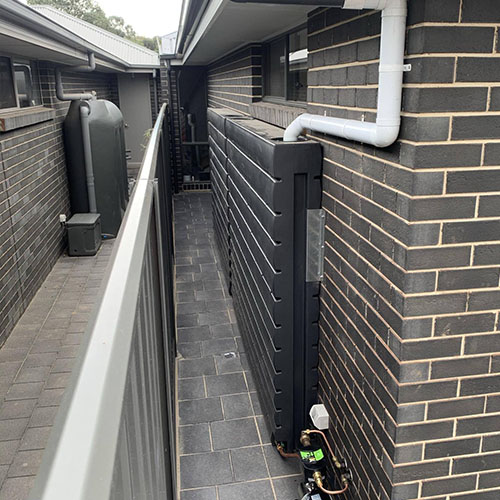Recognizing the Relevance of Rainwater Containers in Drought-Prone Regions for Water Safety
In regions prone to long term droughts, the role of rain storage tanks in bolstering water protection is a topic of expanding value. As neighborhoods grapple with the obstacles of water scarcity, recognizing the importance of these containers goes past mere collection of rain. Rain tanks act as a vital device in mitigating the effect of water shortages by supplying a sustainable resource of water for numerous requirements. Nonetheless, real worth of rain storage tanks expands far past mere storage space; it incorporates resilience-building steps and the promo of long-term water preservation strategies. This diverse strategy to water safety and security warrants a more detailed exam of the role rainwater storage tanks play in making certain a reputable water during times of drought.
Benefits of Rainwater Storage Tanks
Using rainwater tanks provides a sustainable solution for enhancing supply of water and enhancing water safety and security in property and business setups. One of the primary benefits of rain containers is their capability to minimize reliance on mains water supply. By recording and storing rainwater that falls on roofs, this alternate source can be used for various non-potable objectives such as watering, flushing toilets, and cleaning clothing. This not just preserves treated drinking water but additionally reduces water bills for customers.

Rainwater Harvesting Techniques
Rainwater harvesting techniques encompass a variety of methods designed to efficiently collect and store rainwater for various purposes, contributing to water preservation and sustainability. One usual strategy is the installment of roof catchment systems, where rainwater is collected from the roofing system of a building and routed to a storage space container. This technique is fairly easy and affordable. Another preferred strategy is using above-ground or underground tank to keep rainwater for later use. These storage tanks are available in numerous dimensions and materials to match various requirements and can be connected to the existing plumbing system for easy access.

Additionally, rainfall yards and permeable pavements are cutting-edge techniques that include landscape design or paving surfaces in such a way that permits rain to percolate into the ground, renewing groundwater gets. In addition, contour farming and terracing are agricultural techniques that help record rainwater and protect against dirt erosion in hilly terrain. By applying these varied rainwater harvesting techniques, areas can improve water security and resilience in drought-prone regions while promoting lasting water monitoring techniques.
Importance of Water Safety And Security
Making sure trusted access to clean and sufficient water resources is vital for maintaining human health and wellness, financial growth, and ecological health. Water protection is a crucial aspect of societal resilience, particularly in regions vulnerable to dry spells and water shortage. Appropriate water protection encompasses various dimensions, consisting of schedule, top quality, and access of water for residential, farming, industrial, and ecological needs.
Water protection plays a crucial duty in advertising public health and wellness by minimizing the occurrence of waterborne diseases and ensuring sanitation her explanation centers. Financially, water safety and security is important for agricultural productivity, commercial operations, and overall financial development. Slimline water tanks. Furthermore, water security is very closely linked to environmental sustainability, as it sustains environments, biodiversity, and overall eco-friendly equilibrium.
In drought-prone regions, water safety becomes much more crucial because of the enhanced danger of water lacks. Applying methods like rainwater harvesting, water recycling, and effective water monitoring techniques can significantly boost water safety and security in these locations. By prioritizing water protection, communities can much better hold up against the impacts of environment adjustment, population growth, and various other challenges that endanger water schedule.
Enhancing Water Resilience
With raising global water difficulties, constructing resilience in water systems has actually come to be an important emphasis for lasting development efforts. Enhancing water durability entails applying strategies to make certain water availability and quality when faced with transforming ecological problems, such as dry spells, floods, and pollution.
One secret element of improving water strength is advertising using rainwater tanks in drought-prone regions - Slimline water tanks. Rainwater storage tanks function as an efficient methods of recording and saving rain for later usage, lowering dependence on limited freshwater resources during completely dry durations. By including rain harvesting systems right into water administration plans, neighborhoods can improve their capability to endure water shortage and preserve water safety and security

Sustainable Water Conservation
In the middle of rising water challenges, the prudent administration of water sources via sustainable preservation techniques is vital for making certain lasting environmental stability and societal wellness. Lasting water preservation requires the reliable use of water resources to meet present requirements without compromising the capability of future generations to satisfy their own demands. By applying strategies such as rainwater harvesting, greywater recycling, and water-efficient technologies, communities can decrease water waste and minimize stress on freshwater sources.
Moreover, lasting water conservation techniques add to ecosystem health by maintaining adequate water levels in rivers, lakes, and wetlands, sustaining biodiversity, and maintaining all-natural environments. These methods likewise play a vital function in alleviating the effects of environment modification by assisting to adapt to changing precipitation patterns and water schedule.

Verdict
Finally, rainwater storage tanks play an important duty in enhancing water safety and strength in drought-prone regions. By using rain check over here harvesting strategies, communities can decrease their dependence on typical water sources and promote sustainable water conservation techniques. This not only aids alleviate the impacts of water shortage throughout dry spells but also contributes to lasting water protection and resilience in the face of climate modification difficulties.